Moon
2009 dir. Duncan Jones
The film follows “Sam Bell” (Sam Rockwell) an employee of Lunar Industries; a company that produces Helium 3, the cutting edge version of usable energy that is only found on the moon. Since living on the moon for three years with no real human contact Sam has become a broken down, tiresome, grizzly-man version of his former self. The only interaction Sam has is with a robot called “Gerty” (voice of Kevin Spacey), who sends video messages back to earth and keeps the communication flow between Sam’s family and Lunar Industries.
A routine check goes wrong when Sam begins hallucinating an image of a woman (who turns out to be his daughter, played by Kaya Scodelario from the hit UK show, “Skins”) ; he crashes the rover and is left for dead. Then the director brings the viewer back to station he has been living on where another Sam (his clone, Robin Chalk ) awakens on a table. The new Sam goes to search for the lunar rover he supposedly crashed, but when he gets there he finds Sam Bell barely alive. The mystery of Moon unravels when the two Sam characters come together to uncover the real secret behind Lunar Industries.
Moon is a tale of two men that are cut from an identical cloth. Sam Bell is desperately trying to get back home and is quickly deteroriating, while Sam is thriving and devising a plan that will save them both from the wrath of Lunar Industries. For such a low budget film, director Duncan Jones did a great job at making the setting appear tangible and real with the usage of models over the typical digital animation used in Sci-Fi flicks. Moon is a little slow in parts but overall is a smart, sorrowing story about the lengths humans will go to for love, and money, in the case of the culprit.
Written by Rachel Summers
rachel.dustbowl@gmail.com
Night and Fog
In the decade following the Holocaust, conversation on the subject was largely mute. Some people had problems finding a way to conceptualize the evil of Hitler’s Nazi regime, while others simply did not want to think about it. Within this context, French director Alain Resnais decided that the cinema might be a good place to begin the process of breaking through this sense of public amnesia. The result of his inclination was Night and Fog (Nuit et Brouillard) — one of the most important documentary films ever made.
As Fog only runs about 30 minutes, a comprehensive account of the Holocaust is not Resnais’ intention. Instead, with a mixture of black and white still photos and similarly colored archival footage, he briefly explains the forces behind the creation of the Nazi concentration camps and the many horrid aspects of camp life. Throughout the film, Michel Bouquet’s skillfully understated and often ironic narration accompanies images of packed cattle cars, gruesome medical experiments, and scratches on the gas chamber ceiling.
These old photos and bits of footage are juxtaposed with color shots of an abandoned and disintegrating Auschwitz, taken by Resnais in the mid 1950’s. During such segments, the Frenchman cleverly captures the public reluctance to engage the Holocaust with decidedly timid camerawork; as it pans left and right Resnais’ lens often changes speed generating a feeling of shaky unease.
Today, it seems that this feeling has been, for the most part, extinguished from the public mind; there are now scores of films available on the Holocaust. And while the removal of this taboo does make the experience of viewing Fog slightly less meaningful, it shouldn’t prevent people from setting aside half an hour and watching the film. Those who do will be treated to excellent directing on the part of Renais, and exposed to the Nazis’ atrocities with a poignant force that is matched by few, if any, other visual interpretations of the event.
Nathan Walker
nwalker02@hamline.edu
Away We Go
dir. Sam Mendes
I’d been hearing a lot of chatter about this movie for the past few weeks, so, last Tuesday, I decided to see what all the hype was about and watch the thing for myself. To my delight, I was pleasantly surprised with the outcome.
Getting together a cast of characters like Allison Janney, Jeff Daniels, Maggie Gyllenhaal, John Krasinski, and Maya Rudolph certainly proves to work wonders in Away We Go. An expectant couple, Burt and Verona (Krasinski and Rudolph), is in search of the perfect place to start a family. The story bounces all across America while Burt and Verona scope out cities to live in with stops in Arizona, Wisconsin and even into Canada where we meet a mixed bag of characters ranging from Verona’s in-your-face ex-coworker, Lily (Janney) to LN (Gyllenhaal), a free-spirited, childhood friend of Burt’s. Accompanying the film is a mellow, acoustic, Nick Drake-esque soundtrack by Alexi Murdoch which, at times, calms the chaos and constant motion that can ensue when traveling about the country. A prefect movie to kick off summer, Away We Go makes all the right moves and its way onto my dvd’s-to-buy-when-they-come-out list.
— Haley Rheinhart —
haley.dustbowl@gmail.com
Chop Shop
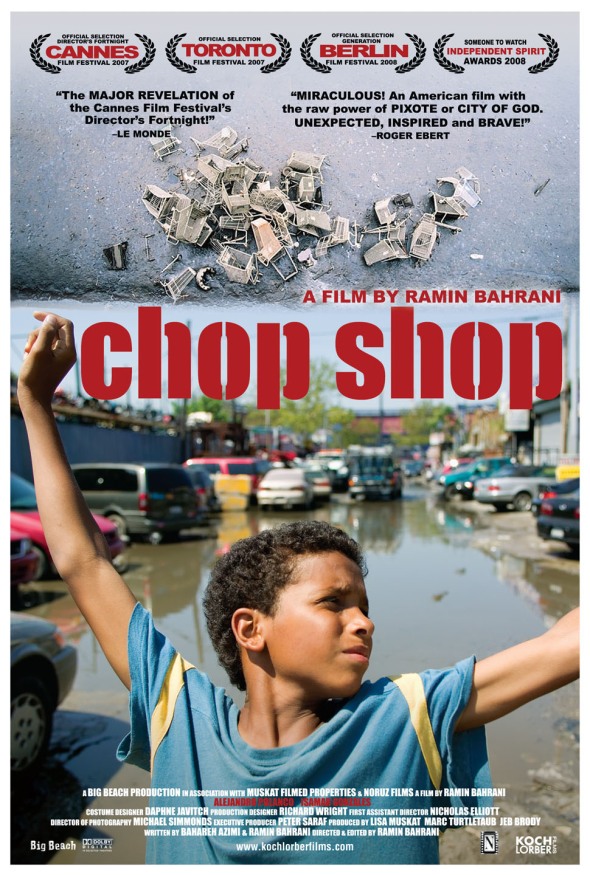
On the Indie film circuit, Ramin Bahrani has emerged as a rising star among directors. His films Man Push Cart, Chop Shop, and Goodbye Solo have all gotten good reviews from a number of critics. I have yet to see Cart or Solo, but Shop certainly lives up to its hype.
Bahrani’s screenplay, co written with Bahareh Azimi, builds around the daily doings of Alejandro (Alejandro Polanco)- a twelve year old Puerto Rican boy who lives in New York City’s Queens Borough. Orphaned and removed from any sort of social service, Alejandro doesn’t attend school, but instead hustles on Queen’s streets for money to survive. Surprisingly, this desolate existence doesn’t get him down; Alejandro shows an incredible amount of resource and optimism as he sells candy bars on the subway near the film’s beginning. Eventually, these same qualities help him land a job at a neighborhood car body shop (hence, the film’s title) owned by Rob (Rob Sowulski), who also lets Alejandro and his older sister Isamar (Isamar Gonzalez) sleep in a small apartment above the garage. Together, the brother and sister work, Alejandro at the shop and Isamar in a food vending truck, to cover their daily expenses and save enough money to fulfill their dream of buying their own food truck.
With his day-in-the-neighborhood format Bahrani shows his familiarity with the work of Spike Lee, and like any good borrower he pays tribute to Brooklyn’s best filmmaker with a number of allusions to Lee’s classic, Do the Right Thing. The most notable of these comes in Shop’s dialogue when Alejandro accuses Isamar of having bad breath, just as Jade does to her brother Mookie early in Thing.
Despite Lee’s obvious influence, Barhrani is still able to construct an aesthetic uniquely his own. Instead of creating an environment that often seems to depart from reality, as Lee does in Thing with his loud dialogue, flamboyant costumes, and discolored cinematography, Barhani builds a world that strongly adheres to the one we already live in. The ability Bahrani shows in Shop to blend his own sense of originality with conventions already established by other important directors makes this film well worth seeing.
Nathan Walker
nwalker02@hamline.edu
The Times of Harvey Milk
This winter, I saw and enjoyed Gus Van Sant’s film, Milk. It sparked my interested learning more about Harvey Milk, the first openly gay man to be elected to political office in America (serving on San Francisco’s Board of Supervisors in the late 1970’s,). So, I decided to check out The Times of Harvey Milk, Rob Epstein’s 1984 Oscar-wining documentary.
While watching Times it soon becomes clear that Van Sant has also seen it. The documentary, roughly speaking, follows the same narrative as the feature– taking the viewer along the path of Milk’s evolution from a camera store owner in the Castro, San Fran’s gay neighborhood, to a political activist, and finally to an elected official who is tragically assassinated. Despite this likeness, Times does not feel like a mere imitation of Van Sant’s film. Instead, the interviews Epstein includes provide detailed explanations of ideas relating to the supervisor’s career that Milk can only allude to, including his campaign methods, relationship with labor unions, and his thoughts on how Gays could reach out to mainstream America.
From a stylistic standpoint, Times’ best moments come during the archival footage Epstein chooses to include. The recycled reels prick many different points along viewer’s emotional spectrum as the frames shift from the wonderfully colorful, vibrant images of cross dressers marching in the Castro’s gay pride parade to shots of fearful and sullen mega-churchgoers as they are instructed on homosexuality’s evils. Unfortunately, Epstein decided to skimp on the total amount of archival footage used for the film; his camera spends far too much time focused on the rather dull faces of the people he interviews, and this causes Times to drag in places. This sense of lethargy is intensified by the narrator, Harvey Feinstein, who, with his fatigued lisp, often sounds as if he is reading from a mediocre history text-book. Still, these flaws are worth the viewer’s perseverance; The Times of Harvey Milk remains a solid piece of film making and its subject is a fascinating character-often overlooked by people interested in American History.
Nathan Walker
nwalker02@hamline.edu
The Edukators
dir. Hans Weingartner
The Edukators (or Die fetten Jahre sind vorbe in German) is like a jump into the life I wish I had the guts to live: young, politically charged, free from inhibition, and daring enough to break into wealthy homes and mess them up. The Edukators is a German film released in 2004 and nominated for the Golden Palm award at Cannes. It’s a story of three German twenty-somethings struggling to live in a society based on ideas they despise. They go to rallies, boycott stores, and protest the government in their free time, but director Hans Weingarter wastes no time showing the harder side of the revolutionary lifestyle: the boring 9 to 5s, struggling to make rent. Our 3 youths, Jan, Jule and Peter, feel the struggle between what they want to do and the reality of modern Germany. Friends Jan and Peter have jobs working for a security company, and they’ve been making random acts of “education”. They break into rich people’s homes while these families are away and rearrange everything. They don’t steal, but instead stack chairs into giant towers in the living room, put collectible statues in the toilet, and misplace the stereo in the fridge. But the piece de resistance of these acts is the notes they leave, saying, “YOUR DAYS OF PLENTY ARE NUMBERED”. When they involve Peter’s girlfriend Jule, she goes on a vendetta against a Mercedes-toting man who has made her life unlivable with debt. They break into his home and do their thing, but everything goes awry when the man, Hardenburg, returns home. Our petty delinquents become kidnappers, and are left with a horrible decision to make.
I absolutely love this movie. The dialogue is so true to life, and we feel the constant struggle between what our heroes know is right and what they must do to survive. Their ideologies are thought provoking and profound, and throughout the movie they make the most valid political points I’ve ever heard anyone say. Seriously- it will change what you think you know about politics, socialism, and modern society. Hardenburg also serves as a personification of the lost idealism, the conformity. He used to be a free-thinker, an activist, but gave it all up for wealth and ease.
This film is one of my all-time favorites. It’s perfect for anyone who’s ever dreamt of seriously messing with the status quo. The movie is in German, which can be a deterrent to some, but I implore you to take a chance and learn something new and gripping from The Edukators.
Casey Magnuson
cmagnuson05@hamline.edu
Into the Wild
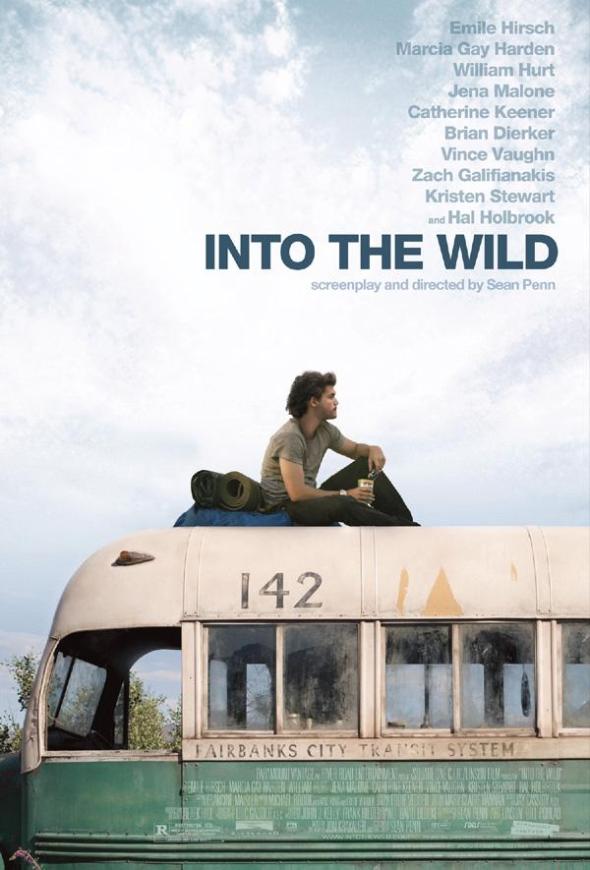
dir. Sean Penn
“If we admit that human life can be ruled by reason, the possibility of life is destroyed.” This quote briefly summarizes the world-view of Christopher McCandless, (Emile Hirsch, Valentino’s new face for the Men’s Spring/Summer 2009 collection)– the protagonist in Sean Penn’s film Into the Wild. Released in 2007, the movie is modeled after Jon Krakuers’ non-fiction book with the same title. Wild chronicles the travels of McCandless, who after graduating from college, decides that he is not suited for 1990’s professional life and takes to the road as a hobo-adventurer. As Penn reveals, many different forces underline Mcandless’ choice to reject normal American life; these, include a frustration with materialism, anger at the restrictions parents (William Hut and Marcia Gay Harden) try to place on his life’s course, and a desire, bolstered by McCandless’ love of classic authors like Thoreau and Tolstoy, to find some sort of fundamental truth in human nature.
Wild feels a lot like a 1990’s movie adaptation of “On the Road”- Jack Kerouac’s classic Beat novel. Like Kerouac’s manic character Dean Moriarty, McCandless, under the absurd name of Alex Supertramp, rambles from one part of America to the next, acting only on the whim of his reckless instincts. Yet, McCandless should not be dismissed as a Moriarty imitator; he possesses both a sense of introspection and compassion for others that escapes Kerouac’s primal womanizer.
The most striking aspect of Penn’s film certainly lies in its setting; the camera follows McCandless as he passes through many of the most beautiful parts of America. The viewer is treated to spectacular scenes of the sand-baked, cactus ridden deserts of the country’s Southwest, the thunderous and foaming rapids on the Rio Grande River, and the eerie expanse of Alaska’s back country. Unfortunately, Penn’s skill as a director and screenwriter does not match the brilliance of the natural wonders he chooses as his backdrop. At some points, the dialogue is weakly crafted- this especially comes through in Mcandless’ exchanges with Rob Franz (Hal Holbrook), an elderly widowed man he meets in Arizona. Despite these flaws, Into the Wild remains an interesting picture; Hirsch gives a strong performance that compels the viewer to reflect on issues relating to the tensions between personal liberty and social responsibility.The inclusion of these ideas makes Penn’s sometimes patchy film making worth viewing.
Nathan Walker
nwalker02@hamline.edu
Sunshine Cleaning

dir. Christine Jeffs
The newest flick by the producers of Little Miss Sunshine is a sweet dramedy without much punch. Amy Adams and Emily Blunt play their roles to perfection with a stunning performance from Alan Arkin.
Sunshine Cleaning follows two out of touch sisters stuck in a rut. Rose (Amy Adams) is still meeting her high school sweetheart late at night in cheap motels despite his marriage to one of Rose’s old cheerleader rivals. Her sister, Norah (Emily Blunt) hasn’t moved out of the house yet and has gone through several waitressing jobs. Her only joy in life seems to be scaring Rose’s son, Oscar (Jason Spevack), with tales of the evil Lobster-man and looking through her dead mother’s belongings while smoking a joint. But when Oscar is forced out of public school Rose needs to make some quick cash to send him to a private school. Rose and Norah decide to team up and start a crime-scene clean-up business, which ends up bringing them closer better lives and each other.
The film runs a little long, and I expected a much more satisfying ending, however, the story seems true to life and was enjoyable nonetheless. Though Sunshine Cleaning is certainly not the next Juno, it has a quirky humor and a wonderful sentiment all its own.
Katie M. Gaulke
kmgaulke@csbsju.edu
Sugar
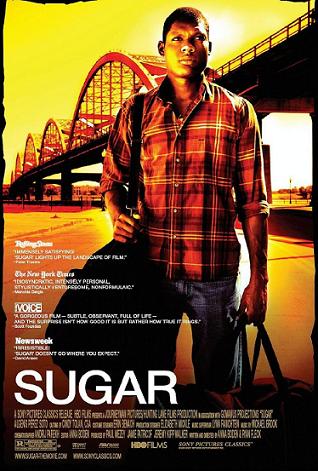
Sugar — A new age, need to see, baseball story. The duo Anna Boden and Ryan Fleck team up once again to create Sugar, a tale of a young dominican baseball player who comes to America on a baseball dream ride. Both were apart of the making of the Sundance, indie hit, Half Nelson (starring Ryan Gossling). This film places you in the poor areas of the Dominican Republic, following the character Miguel “Sugar” Santos, who is recruited by the United States as a promising starting pitcher. Now in the States, Miguel realizes that life in baseball isn’t the best dream for him, so he moves to New York City seeking another. Visually beautiful, filled with vibrant colors and true baseball sequences, the directors Fleck and Boden created a story worth telling and watching; their success is supported by the incredible acting power from real players in the D.R. rather than actors.
Fleck and Boden made an appearance after the screening of their film at this year’s Beyond Borders Film Festival in Minneapolis this March 2009 (the first of its kind), and explained the plot as one that originated from a combination of real journeys of Dominican immigrants to America. It releases this week at the Lagoon Cinema in Minneapolis.
By Matt Cici
This is England

Reggae enthusiasts are sure to enjoy This is England. The film, released in 2006 and both written and directed by Englishman Shane Meadows, features three classics from the acclaimed Reggae group Toots and the Maytals. Maytals fans, who watch the movie, will be treated to performances of the jarring prison chant “54-46 was my Number”, “Pressure Drop”-one of the group’s whimsical dance numbers, and “Louie, Louie”-a cover of the Kingsmen’s drunken classic which the Maytals slow down, giving the song a pleasantly unique feel. Besides his good taste in soundtracks, Meadows displays a bright talent as both a writer and director. With “England’s” screenplay, he crafts an engaging narrative, set in early 1980’s Britain, which explores the advent of various working class Skinhead groups as a response to the decline of the nation’s industrial economy and increase in the size of its immigrant population.
Meadows’ protagonist, a twelve year old boy named Sean (Thomas Turgoose) who is raised by his Mother since his Father died in the Falkland War (still in progress during the time period the film portrays), lives in the poor section of an unnamed English city which has been spared none of the economic strife brought on by post-industrialization. Throughout the film, this reality of financial decay is constantly present as abandoned factories, graffiti ridden underpasses, and decrepit apartment complexes serve as the backdrop for most of the character interaction. Despite growing up in such an uncharacteristically harsh environment, Sean’s main difficulty in day-to-day life could be faced by any boy his age: he can’t seem to fit in at the local school. Due to his outdated clothing, Sean becomes a target for the insults of older children; yet, as the film progresses, being picked on turns out to benefit him, as it draws the sympathy of a number of older teens- who happen to be Skinheads. Sean befriends this rather dubious group, and the rest of the movie depicts the evolution of his relationships with its various members. Given the crude racism practiced by some people in the clique, Sean, by the film’s end, is forced to make a choice between maintaining his friendships and rejecting bigotry. For the impressionable twelve year old, this is anything but easy.
Meadow’s skill as a filmmaker becomes apparent in his ability to fluidly establish social and political context. He accomplishes this in England’s first three minutes where he, with “54-46” as sound, places a montage of news footage containing various elements of British life during the early 1980’s. These wordless images clearly show an England that is divided between a satisfied majority that passes its time ogling at Princess Di, taking dance aerobics, and, most importantly, voting for Margret Thatcher’s Tory government, and a frustrated minority that splits in two ideological directions: radical leftists are identified as they assault the Island Nation’s missile silos and Right-wing Skinheads while doing the same to the homes of immigrants. Meadows’ use of this montage marks an important innovation concerning the construction of polemical films. In the past, such movies, when trying to provide the viewer with contextual insight, have often resorted to fragmented discussion between characters that inevitably comes across as insincere (see Ghandi or another Skinhead film American History X for examples). Meadows, through his collection of news images, has found an effortless way to avoid this hitch. This simple, but clever style of directing remains constant throughout This is England and makes the film well worth watching.
Nathan Walker
nwalker02@hamline.edu
Midnight Cowboy

Winning Best Picture in no way guarantees the quality of a film, but in the case of Midnight Cowboy it seems the Academy got this one right. The movie, which received the honor in 1969, stars Dustin Hoffman and Jon Voight; it begins with the character Joe Buck, played by Voight, a Texas dishwasher, who wears a flamboyant Cowboy costume, deciding to leave the Lone Star State for New York City to seek his fortune. Not long after Buck reaches his destination, he encounters Rico Rizzo a clever, but crippled Italian hustler played by Dustin Hoffman who has acquired, due to his habit of petty theft, the derogatory nickname “Ratso.” The meeting serves to spark an enduring relationship, full of high and low points, as both men try to survive the poverty that befalls them in the Big Apple’s Rat-Race.
In revealing the story of Rizzo and Buck, the Director, John Schlesinger, captures a vivid picture of the two parallel worlds that existed in the New York of the late 1960’s: one of opulent Penthouses and Luxury Hotels on Fifth Avenue and the other of its raw underbelly located on Forty-Second Street- the city’s outlandish skid row full of gays, transvestites and other so called “deviants”. Buck must negotiate both of these environments as he tries to make his way as a male prostitute (he prefers women, but must also offer his services to men out of desperation for money) under Rizzo’s guidance. Due to Buck’s, occupation, “Cowboy” has a number of graphic sex scenes, but this should not cause the viewer to dismiss it as vulgar. Buck’s sexual escapades do not disrupt the film’s rhythm, but, instead, aid in its nuanced exploration of ideas relating to the significance of physical identity, interplay of mainstream and countercultures, coercive impact of advertising, bane of American individualism in trying to confront poverty, and much more. Given its intellectual maturity, this film will be a good renting choice for movie-goers wishing to escape the shallow barage of blockbusters Hollywood has in store for the coming summer.
If you enjoy Dustin Hoffman make sure to see The Graduate (everyone really loves the Simon and Garfunkel soundtrack that accompanies this one) and Tootsie.
Nathan Walker
nwalker02@hamline.edu
King of California
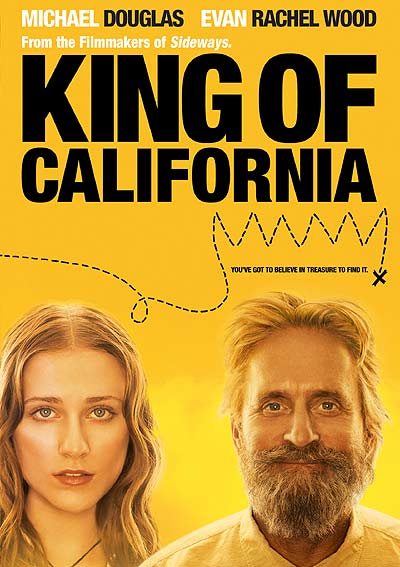
On this snowy April Fool’s day, the joke is literally on our Minnesota streets. When I think of April Fool’s, fool’s gold (and not the film starring Kate Hudson and Matthew McConaughey) comes to mind. 2007‘s King of California, directed by Michael Cahill, is one of my favorite treasure hunt movies, besides The Goonies. The film stars, Evan Rachel Wood and Michael Douglas it centers around the relationship of father-daughter pair Charlie and Miranda. Miranda’s estranged father comes back into her life after his stint in a mental institution. Charlie finds a treasure map and is on the search for gold left by Spanish conquistadors. He pulls his daughter into his hair-brained scheme and they end up digging up the state of California. King of California is a touching story of hope and disappointment. It exudes a love for family and the care-free essence of childhood dreams in every morsel of dirt that is dug up.
Written by Rachel Summers
rachel.dustbowl@gmail.com
Adventureland
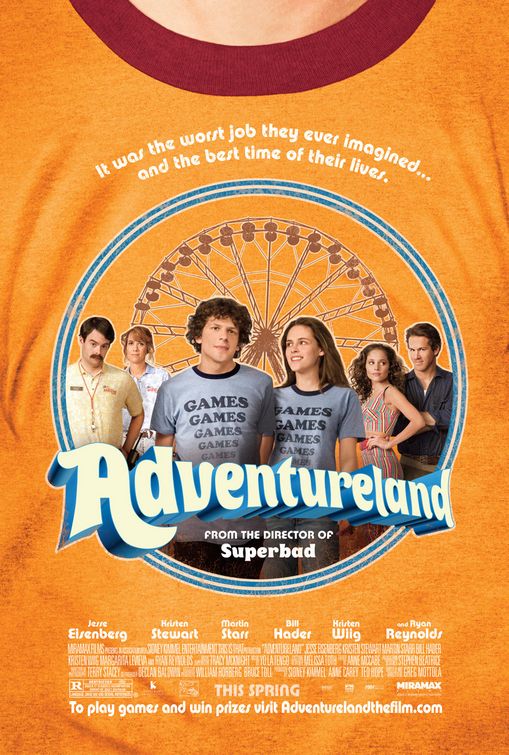
I usually lay in wait of good potential comedies and I am crossing my fingers and holding my rabbit’s foot for Adventureland. The cast intrigues me more than the film at this point. James (Jesse Eisenberg) and Em (Twilight phenom Kristen Stewart) are bound to break the “no falling for your co-worker” rule in this one. It’s a film about a terrible summer job at an amusement park in 1987 that turns in to summer lovin’ for James. The feeling just from the trailer is that it is “Freaks and Geeks” (an amazing cult show about the 80’s before FOX made that epic fail attempt at making “That 80’s Show”) meets Wayne’s World. Then again, it could be that Martin Starr from “Freaks and Geeks” is in the film. Fortunately, the soundtrack is infused with great 80’s hit’s like The Cure’s “Just Like Heaven,” Big Star’s “I’m in Love with a Girl,” and The Replacement’s “Unsatisified.” Adventureland, directed by Greg Mottola is set to hit theaters on April 3rd, 2009.
Other Jesse Eisenberg films you should see:
The Squid and The Whale–it’s a quirky tale about a family’s dysfunctional relationship with one another set in Brooklyn in the 80’s.
Kristen Stewart films:
Into the Wild— It has incredible cinematography and Emile Hirsch.
Panic Room–I enjoy a good Jodie Foster thriller every once a while, Forest Whitaker is in it too. While you’re at it, see The Last King of Scotland.
Written by Rachel Summers
rachel.dustbowl@gmail.com
Gigantic
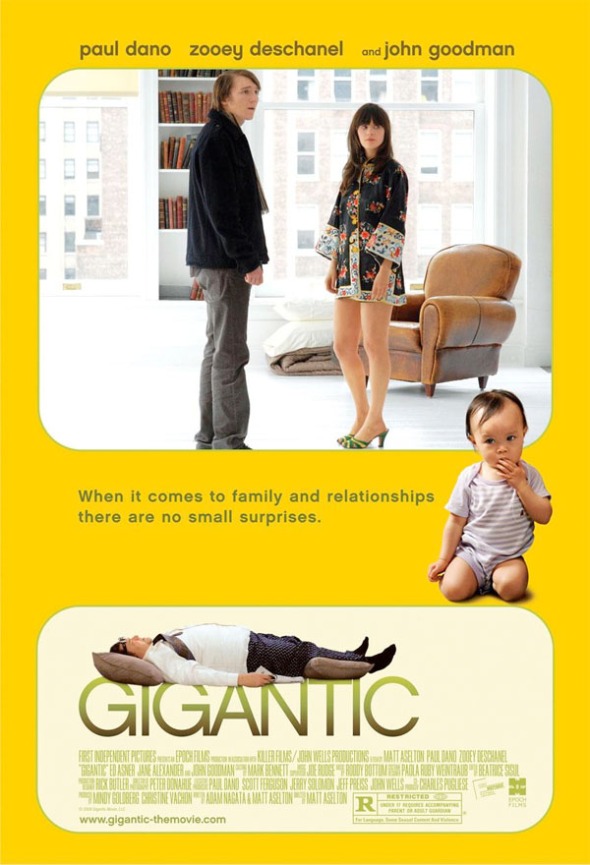
directed by Matt Aselton
Who didn’t love the tongue-tied, angst-y teenaged Dwayne Hoover from Little Miss Sunshine? Well, this April, Paul Dano is hitting the big screen again with what looks to be another quirky, off-kilter comedy costarring John Goodman and, our favorite, Zooey Deschanel.
Here’s the story, morning glory…
Mattress salesman, Brian Weathersby (Dano) has plans to adopt a chinese baby, but as Harriet “Happy” Lolly (Deschanel) comes into the picture and falls asleep on a bed in his store one day, things get complicated. The two fall for each other but must find a way to deal with each other’s wacky families (Happy’s father, Al Lolly (Goodman))in order to be together.
Looks like the soundtrack will be featuring some Animal Collective. Promising…
Will it be this year’s Juno? It may be too soon to say. We’ll just have to wait until May 22nd, when Gigantic opens at select theatres around the Twin Cities (or April 3rd for NY and April 10th for Chicago).
Watch the trailer, especially for John Goodman’s glasses, they’re freakin’ rad.
— Haley Rheinhart —
haley.dustbowl@gmail.com
Man On Wire.
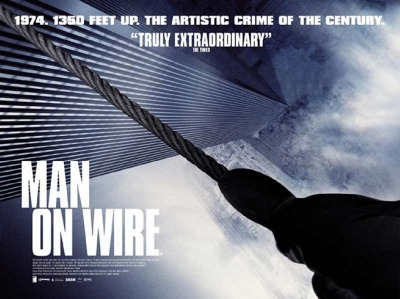
The Dustbowl team recently had the chance to watch this documentary and we absolutely loved it. Directed by James Marsh, Man on Wire won this year’s Oscar for Best Documentary. The story follows Philippe Petit and his seemingly impossible dream of traversing a wire between the newly built Twin Towers of the World Trade Center in New York City. The tension looms as an international entourage comes together to help one man fulfill his destiny. The cinematography gives the audience a first-hand account of what a wire walker goes through, intertwining the careful arrangement of every detail with the suspenseful (and illegal) execution of the scheme in 1974. 2008’s Man On Wire kept us on edge as Philippe gracefully stepped from tangible stability to unstable territory.
Written by Rachel Summers & Haley Rheinhart
rachel.dustbowl@gmail.com
haley.dustbowl@gmail.com
500 Days of Summer
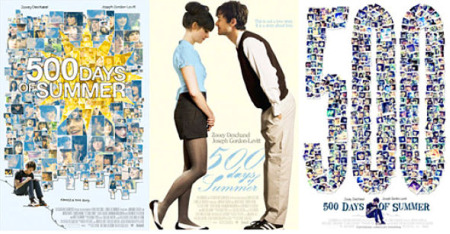
It’s never too soon for summer, director Marc Webb and screenwriters Scott Neustadter and Michael H. Webber bring the trailer of 500 Days of Summer opening July 17, 2009. The film stars Joseph Gordon-Levitt as “Tom” and Zooey Deschanel as “Summer.” Love is usually a reciprocal process, but in Tom’s case it isn’t. His heart was harpooned by Summer. Tom must figure out the specific point in which his 500 day relationship with Summer went askew in order to win her back. The soundtrack plays a heavy role in the film, because pop songs guide Tom through his journey. There is even a musical dance number, now that takes guts since Gordon-Levitt isn’t a mouseketeer.
The track listing inflates the bubble surrounding this movie:
Regina Spektor – “Us”
The Smiths – “There Is A Light That Never Goes Out”
Belle & Sebastian – “The Boy With The Arab Strap”
Black Lips – “Bad Kids”
The Smiths – “Please, Please, Please, Let Me Get What I Want.”
Patrick Swayze – “She’s Like The Wind.” (Yes, Patrick Swayze, the Dirty Dancing phenomenon!)
Jack Penate – “Have I Been a Fool? ”
The Doves – “There Goes the Fear”
Hall & Oates – “You Make My Dreams”
Knight Rider Theme
Temper Trap – “Sweet Disposition”
Carla Bruni – “Quelqu’un M’a Dit”
Black Lips – “Veni, Vidi, Vici”
Paper Route – “The Music”
Feist – “Mushaboom”
Regina Spektor – “Hero”
Spoon – “Infinite Pet”
Simon & Garfunkel – “Bookends”
Wolfmother – “Vagabond”
Mumm-Rah – “She’s Got You High”
Poison “Every Rose Has Its Thorn”
Nancy Sinatra/Lee Hazlewood as performed by Zooey Deschanel “Sugar Town”
The Pixies “Here Comes Your Man”
Other Zooey Deschanel films worth your while:
Winter Passing, The Go-Getter, and Flakes.
Other Joseph Gordon-Levitt films worth your while:
Manic, Mysterious Skin, Brick, and The Lookout.
Written by Rachel Summers
rachel.dustbowl@gmail.com
Gus Van Sant’s Milk out on DVD today
Alright guys, are you ready for this? Finally, The Dustbowl’s first official film blog! Up until now, we’ve really only been doing music and music-related posts. We’re trying to include more film blogs, so keep an eye out for more in the near future…

Well, today is the day. You can go out and buy your very own copy of Milk on DVD. Depicting the true story of Harvey Milk, the first openly gay man elected to a major political office in the United States, Milk is chalk full of exceptional performances by Emile Hirsch, James Franco, Allison Pill, Diego Luna, and Josh Brolin, just to name a few. And, of course, how could I forget Sean Penn’s Academy Award wining portrayal of Milk. In total, the film picked up two Oscars at this year’s Academy Awards; one for Best Actor and the other for Best Original Screenplay. If you haven’t already seen this film, now is your chance. Seriously, do it. It will be well worth your while.
Also…if you’re really into Gus Van Sant’s directing style, see the movie Elephant (2003). I’ve seen it a few times and it still makes me a little uneasy (in a good way).

— Haley Rheinhart —
haley.dustbowl@gmail.com






